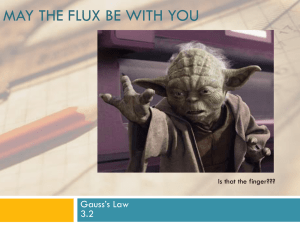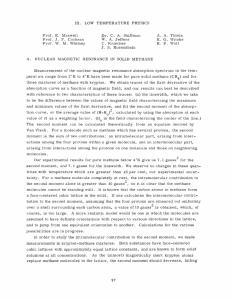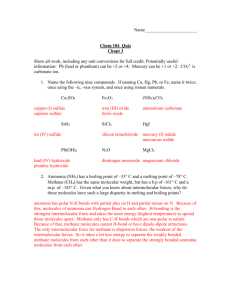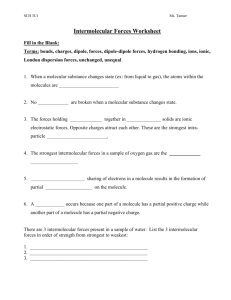IV. LOW TEMPERATURE PHYSICS Prof. E. Maxwell
advertisement
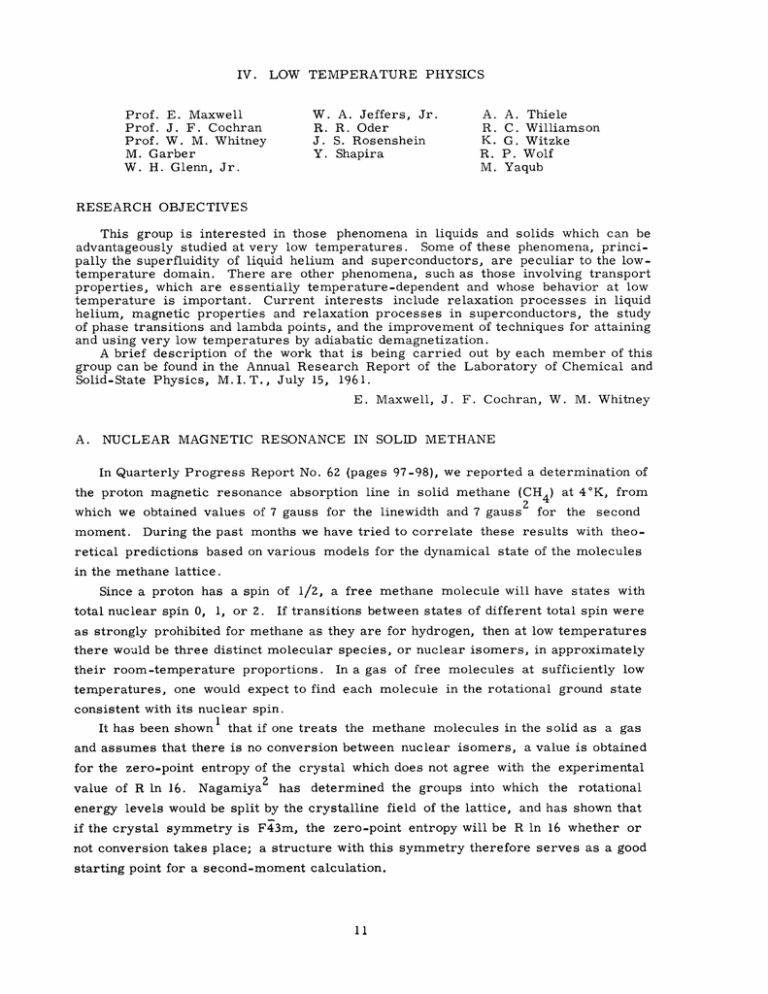
IV. LOW TEMPERATURE PHYSICS A. R. K. R. M. W. A. Jeffers, Jr. R. R. Oder J. S. Rosenshein Y. Shapira Prof. E. Maxwell Prof. J. F. Cochran Prof. W. M. Whitney M. Garber W. H. Glenn, Jr. A. Thiele C. Williamson G. Witzke P. Wolf Yaqub RESEARCH OBJECTIVES This group is interested in those phenomena in liquids and solids which can be Some of these phenomena, princiadvantageously studied at very low temperatures. pally the superfluidity of liquid helium and superconductors, are peculiar to the lowtemperature domain. There are other phenomena, such as those involving transport properties, which are essentially temperature-dependent and whose behavior at low temperature is important. Current interests include relaxation processes in liquid helium, magnetic properties and relaxation processes in superconductors, the study of phase transitions and lambda points, and the improvement of techniques for attaining and using very low temperatures by adiabatic demagnetization. A brief description of the work that is being carried out by each member of this group can be found in the Annual Research Report of the Laboratory of Chemical and Solid-State Physics, M.I.T., July 15, 1961. E. A. NUCLEAR Maxwell, J. F. Cochran, W. M. Whitney MAGNETIC RESONANCE IN SOLID METHANE In Quarterly Progress Report No. 62 (pages 97-98), we reported a determination of absorption line in solid methane (CH 4 ) at 4°K, from 2 which we obtained values of 7 gauss for the linewidth and 7 gauss for the second the proton magnetic resonance moment. During the past months we have tried to correlate these results with theo- retical predictions based on various models for the dynamical state of the molecules in the methane lattice. Since a proton has a spin of 1/2, a free methane molecule will have states with total nuclear spin 0, 1, or 2. If transitions between states of different total spin were as strongly prohibited for methane as they are for hydrogen, then at low temperatures there would be three distinct molecular species, or nuclear isomers, in approximately their room-temperature temperatures, proportions. In a gas of free molecules at sufficiently low one would expect to find each molecule in the rotational ground state consistent with its nuclear spin. It has been shown that if one treats the methane molecules in the solid as a gas and assumes that there is no conversion between nuclear isomers, a value is obtained for the zero-point entropy of the crystal which does not agree with the experimental value of R In 16. NagamiyaZ has determined the groups into which the energy levels would be split by the crystalline if the crystal symmetry is rotational field of the lattice, and has shown that F43m, the zero-point entropy will be R In 16 whether or not conversion takes place; a structure with this symmetry therefore serves as a good starting point for a second-moment calculation. (IV. LOW TEMPERATURE PHYSICS) Assuming that the molecules do not move, we obtain a value of 10 gauss2 for the intermolecular Nagamiya. contribution to the second moment for the structure proposed by The intramolecular second moment for a stationary molecule is 33 gauss so the total rigid lattice second moment would be 43 gauss . value of 7 gauss 2 The low experimental indicates that the molecules are in motion, and allowances must be made for this motion in calculating theoretical second moments. Tomita 3 has calculated the shape of the absorption line in solid methane for the F43m structure under the assumption that the nuclear isomers do not readily convert at low temperatures. His analysis leads to a linewidth of 7.5 gauss, which is attributable to intramolecular interactions alone. He estimates that the intermolecular second 2 moment will be 7. 3 gauss . While he does not state a value for the total second moment, he does plot a curve from which we obtain a value of 15 gauss 2 as an absolute lower limit. Tomita's results appear to be in good agreement with a line shape deduced by Thomas, Alpert, and Torrey4 from pulse measurements of the spin-spin relaxation time (T 2 ) in solid methane, but do not agree with our measurements, in which line shape is measured directly. As we reported in Quarterly Progress Report No. 62, we tried to separate the intramolecular contribution to the second moment from the intermolecular one by diluting the methane lattice with krypton. Preliminary results indicated that when the second moment was extrapolated to 100 per cent Kr, a value of 2 gauss 2 remained, but, since then, we have shown that our lines at 50 per cent Kr and at 90 per cent Kr were instrumentally broadened. For 90 per cent Kr we now obtain second moments in the range 0. 6-0. 9 gauss 2, and we conclude that the intramolecular second moment is probably zero in dilute solutions. If the crystalline field had the same symmetry in the dilute solutions as in the pure crystal, we would have expected a large intramolecular contribution from the molecules with nuclear spin 1, on the basis of Tomita's analysis. No one has established that nuclear isomers of the methane molecule do or do not convert readily in the solid, and it is worth considering the consequences of the assumption that they do. If total nuclear spin were not a good molecular quantum number, each molecule would be free to drop into its lowest state. For the highly symmetrical methane molecule in a cubic environment, this state would be very mych like the J = 0 state of the free molecule, for which all angular orientations are equally probable. We have calculated the intermolecular second moment for a face-centered cubic lattice of methane molecules in J = 0 states, and obtain an upper limit of 4.4 gauss 2 . This number lies below the experimental one, but it is clear that any attempts to make allowances for effects of the crystalline field or for cooperative motions of the molecules will make the agreement better rather than worse. If one can treat the motions of the methane molecules without regard to the inhibitions imposed by their nuclear spins, it would be expected that the deuterated methanes (IV. LOW TEMPERATURE PHYSICS) should exhibit essentially the same behavior as CH 4 in their crystalline ground states. For CH 3 D, which has only three protons instead of four, the intermolecular proton second moment should be simply three-fourths that of CH 4 , or approximately 5.3 gauss 2 During the summer, A. Dammig, a senior thesis student, measured the second moment of CH3D at 4°K. The average value of the second moments obtained from the first run was approximately 5.5 gauss . On each of two subsequent runs, were progressively higher, attaining values as high as 8 gauss2 . upward trend of the data however, the results We believe that the represents the effect of a leaking of large amounts of air (containing paramagnetic oxygen) into our ampoule during a run, and have redesigned our apparatus so that ampoules that are permanently sealed off can be used. Until the precision of our CH3D measurements has been improved, we cannot claim support for our hypothesis. It is worth pointing out, however, that the second moment for a rigid 2 CH 3 D lattice would be approximately 29 gauss , and we feel confident in ruling out the possibility that the lowest phase transition in CH3D represents a freezing-out of the molecular reorientation. W. M. Whitney, J. S. Waugh References 1. A. Frank and K. Clusius, 2. T. Nagamiya, 3. K. Tomita, 4. J. Z. physik. Chem. Progr. Theoret. Phys. Phys. Rev. 89, B36, (Kyoto) 6, 291 (1937). 702 (1951). 429 (1953). T. Thomas, N. L. Alpert, and H. C. Torrey, J. Chem. Phys. 18, 1511 (1950).
